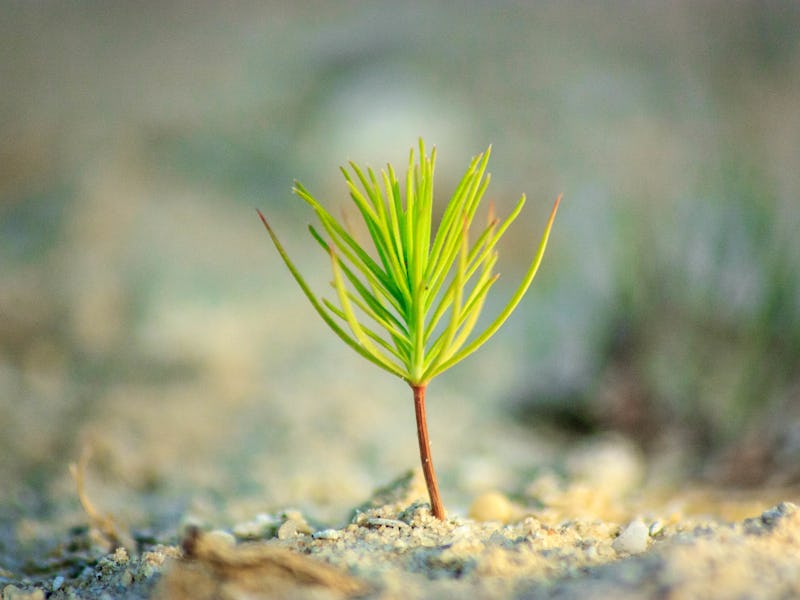Everything We've Achieved Since the Very First Earth Day
It's not all doom and gloom.

Humans have maxed out the atmosphere’s carbon dioxide limit, destroyed the coral reefs, melted the polar ice caps, and even found a way to create earthquakes for the last drops of fossil fuel left in the ground. But it’s Earth Day, so we have to try to celebrate the victories. Here are some of the best moves we’ve made since the first Earth Day on April 22, 1970.
U.S. Policies
While the environment is less healthy than it was in the past, American policies meant to protect what’s left of it have come a long way since the first Earth Day.
- The Clean Water Act, established in 1972, was the first law to ensure regulations for U.S. waters. In the same year, the Marine Protection, Research, and Sanctuaries Act was established to prevent ocean dumping.
- The Clean Air Act, established in 1970, regulates emissions of harmful greenhouse gases. It’s the reason we no longer have deathly smog, like the cloud that killed 168 people in November of 1966.
The view to the south from the Empire State Building on Nov. 24, 1966, one of New York’s worst smog days.
- The Environmental Protection Agency, established in 1970, is probably America’s greatest environmental achievement. It led to momentous federal research on air, land, and water safety and conservation, and coaxed policymakers to set standards to protect wildlife and human health.
- The Endangered Species Act of 1973, is the only U.S. law that gives rights to wildlife. Because of this act, we’ve saved bald eagles, grizzly bears, gray wolves, humpback whales, manatees — and, thanks to global efforts, pandas!
Scientific Advancements
Fifty years ago, Americans had a feeling something was wrong with the natural environment — but they just weren’t sure what. Since then, science from multiple fields has overwhelmingly pointed at climate change as the culprit. Similarly, scientific breakthroughs have elucidated a lot of the other problems humans deal with day to day.
- In 1995, Paul Crutzen, Mario Molina, and Sherwood Rowland won the Nobel Prize for their perseverance in studying ozone depletion. As early as 1970, Crutzen became the first scientist to notice that the ozone layer was depleting, linking this damage to nitrogen oxide released by aircrafts. In 1974, Rowland and Molina demonstrated that CFC gases, or freons, also damaged the ozone. Together, this research led to the Montreal Protocol, an international agreement to completely phase out the use of CFCs in refrigeration devices, aerosol sprays, and solvents.
- When Rachel Carson’s controversial Silent Spring was published in 1962, it sent scientists scrambling to link the use of DDT — the so-called “miracle” pesticide that was used everywhere to kill mosquitoes — to the rapid decline of bald eagle populations. In 1972, the U.S. government banned the use of DDT, and sure enough, by 2007, the bald eagle population made a full recovery.
- In 1999, a team of scientists found the connection between the rapid death of coral reefs and increased carbon dioxide in the atmosphere. This notable study has sparked almost two decades of intense research on marine biodiversity. Although the reefs are still in grave danger, the original study has helped spark several movements aiming to save this vital part of the Earth’s ecosystem.
Cultural Movements
In response to many climate change disasters, such as sea level rise, increased drought and flooding, glacial melt, deforestation, and fossil fuel depletion, numerous large-scale organizations now exist to defend nature.
- Greenpeace, founded in 1971, has quickly become one of the country’s leading environmental action groups. It’s known for its outrageous life-threatening stunts; its first — and still most notable — achievement was sailing a small boat into Amchitka island off the coast of Alaska, putting its passengers in harm’s way to stop nuclear testing in the area.
- The U.S. Climate Action Network, also a huge proponent of environmental action, has worked with the United Nations to meet climate goals since the negotiation of the Earth Summit in Rio de Janeiro in June 1992.
- The Ocean Conservancy, founded in 1972, has made significant progress in protecting the world’s oceans and is one of the few organizations that focuses solely on marine life. In the past 25 years, its volunteers have removed 144 million pounds of trash from beaches during the International Coastal Cleanup and have also derailed proposals to reopen international trade in sea turtle products, ending Japanese imports of Hawksbill sea turtle shells.
Green Tech
America’s eco-friendly technology has lead to the burgeoning renewable energy movement and may be just what the country needs to finally kick fossil fuels to the curb.
- Electric Cars are disrupting the auto market for the first time since their inception. Today’s most promising zero-emissions cars include Elon Musk’s Tesla Model S, the Fiat 500e, the Chevy Bolt, the BMW i3, and the Mercedes B250e.
- Okay, America didn’t invent solar energy, but it is certainly getting better at installing solar panels nationwide. According to the Solar Energy Industry Association, 14.8 gigawatts’ worth of solar energy panels were installed in 2016, and nationwide, 42 gigawatts’ worth of panels are installed — enough to power 8.3 million homes. Also, about 260,000 Americans work in the solar industry.
- American inventor John B. Goodenough designed the first lithium ion battery in 1980 — a rechargeable battery that’s now used in green tech such as electric cars, solar cells, boat motors, surveillance systems, and smartphones.
Tesla Model S charging up.
It’s not all doom and gloom: With a little government intervention, a few bright minds, and some crazy enough ideas, humans can succeed in saving the world we appear to be destroying. In the spirit of Earth Day, let’s focus on how far we’ve come and garner some optimism for where we’re going next.